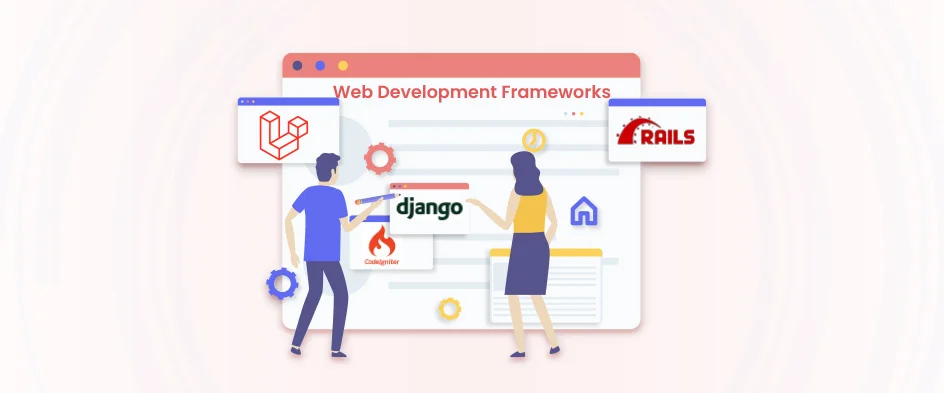Web Development Frameworks: Choosing the Right One for You

- 8 Minutes to read
Table of Content
- What do the Web Development Frameworks do?
- Top Web Development Frameworks
- How to Choose the Best Web Development Framework?
- Conclusion
- FAQs on Web Development Frameworks
Sometimes, web development can feel overwhelming, with mountains of codes and programs to be executed for the project. So, it’s understandable to look for tools that can streamline the process and help create exceptional web experiences. That’s where the web frameworks come in.
Web development frameworks are collections of pre-written code libraries, tools, and best practices that simplify the web development process. Instead of starting from scratch every time, developers leverage the framework’s structure to build upon. The experts use them to reduce the development time and effort.
In this blog, I’ll tell you all about the top frameworks preferred by professional web development companies and why. But first, let’s see what the frameworks do.
What do the Web Development Frameworks do?
The web development frameworks are of three types: frontend, backend, and full-stack. The frontend frameworks focus on building user interfaces, handling user interactions, and displaying dynamic content. Then, there are the backend frameworks that manage server-side logic, handle database interactions, process requests, and generate responses.
Finally, the full-stack frameworks offer a comprehensive set of tools for building both frontend and backend aspects of web applications.
These frameworks handle a whole range of tasks typically required in web development. So the developers can focus on the unique aspects of their project. Here’s a breakdown of what they do and offer:
- User Interface (UI) Building: Frontend frameworks offer pre-designed components and functionalities for building interactive and dynamic UIs. So, there’s no need to code everything from scratch.
- Backend Logic: Frameworks like Express.js, Django, and Ruby on Rails provide libraries and tools for handling server-side tasks like database interactions, routing, and user authentication, saving developers time and effort.
- Security: Many frameworks have built-in security features like input validation and data encryption. So the developers can avoid vulnerabilities and protect their applications.
- Standardized Conventions: Frameworks enforce specific coding styles and patterns, leading to cleaner, more maintainable code. This is crucial for larger projects with multiple developers working on the same codebase.
- Component-Based Architecture: Frameworks like React encourage breaking down the user interface into reusable components. It promotes modularity and easier code management.
- Pre-built Components: By providing ready-made solutions for common tasks, frameworks significantly reduce development time. Developers can focus on the project’s unique features and functionalities instead of reinventing the wheel.
- Testing Tools: Many frameworks come with built-in testing tools or integrate well with popular testing frameworks. So the developers can write and run tests efficiently, ensuring code quality and preventing bugs.
- Faster Prototyping: With pre-built components and organized structures, frameworks enable developers to quickly build prototypes and test their ideas. That accelerates the development process.
The best web development companies use them to enhance the functionality and security of web apps and foster collaboration within the development teams.
Top Web Development Frameworks
As you may already know, there are several frontend, backend, and full-stack web frameworks available online. But now all of them will be suitable for your project. So here, I have listed the top options that would be most beneficial to your project.
AngularJS
Released in 2010, AngularJS is a JavaScript framework for building web applications. It is known for its two-way data binding. So, the changes in the UI are automatically reflected in the underlying data and vice versa. That simplifies development and reduces manual coding.
This framework also offers a comprehensive set of tools for development, testing, and deployment, streamlining the process. It boasts enterprise-grade features like modular architecture, dependency injection, and extensive documentation. So it’s suitable for large projects.
Key Features of AngularJS
- Two-Way Data Binding: This flagship feature automatically keeps the view and model in sync. It simplifies development by eliminating the need for manual data manipulation.
- MVC Architecture: AngularJS adheres to the Model-View-Controller (MVC) architecture. The model manages data, the view displays information, and the controller handles user interactions and updates the model.
- Dependency Injection: Instead of explicitly creating and managing dependencies, AngularJS injects them into components. This promotes modularity, testability, and cleaner code.
- Routing: Manages navigation between different views based on URL changes. This allows for seamless interaction within a single-page application.
- Directives: These custom HTML attributes extend the functionality of HTML elements. They add behavior, manipulate the DOM, and interact with data, allowing for dynamic and interactive UI.
AngularJS also incorporates features like scopes (isolated data environments), promises (asynchronous operations), and filters (data transformation). That enriches the web development experiences quite effectively.
ReactJS
Released by Facebook in 2013, ReactJS, often simply called React, is a JavaScript library for building interactive UIs. Your UI is built from reusable components, each representing a distinct part of the interface. This promotes modularity, maintainability, and code reusability.
An in-memory representation of the real DOM that React efficiently updates. It minimizes expensive DOM manipulations and improves performance. ReactJS also employs JSX, a syntax extension that blends JavaScript and HTML. It makes the code more readable and intuitive for UI development.
Key Features of ReactJS
- Declarative: You describe what the UI should look like, and React handles how to achieve it. It makes code easier to understand and reason about.
- Unidirectional data flow: Data flows from parent to child components. That ensures predictable state management and prevents unintended side effects.
- Virtual DOM: Improves performance by minimizing real DOM manipulations. It leads to smoother and faster UI updates.
- Component-Based Architecture: The core philosophy of React is components. You build your UI by composing reusable components, each representing a distinct part of the interface.
- Unidirectional Data Flow: Data in React flows in one direction: from parent components to child components.
The component-based approach, virtual DOM, and a large ecosystem of ReactJS make it a popular choice for both small and large-scale web applications.
Vue.js
Vue.js is a JavaScript framework for building user interfaces. Known for its simplicity, flexibility, and performance, it has gained significant traction in recent years, offering a compelling alternative to frameworks like React and Angular.
You can use Vue incrementally, adding features as needed. Start small with basic HTML, CSS, and JavaScript, and gradually incorporate advanced functionalities like routing, state management, and more. Similar to React, you describe the desired UI state, and Vue handles the updates efficiently. That simplifies development and promotes readability.
Key Features of VueJS
- Progressive Framework: Vue.js takes a “progressive” approach, offering a core library focused on the view layer. You can incrementally add features like routing, state management, and more as needed.
- Directives: Directives are special attributes that extend HTML elements with additional functionalities.
- Two-way data binding: Optionally enables automatic synchronization between data and the UI, simplifying development for certain use cases.
- Reactivity: Efficiently updates the UI whenever underlying data changes, ensuring a dynamic and responsive user experience.
- Virtual DOM: Like React, Vue uses a virtual DOM for efficient updates, ensuring smooth and performant UIs.
Vue.js offers a compelling blend of simplicity, performance, and flexibility. Its component-based architecture, reactivity system, and templates help developers build dynamic UIs with ease.
Laravel
Laravel, a free and open-source PHP framework, has become a popular choice for building modern web applications. It’s renowned for its expressive syntax, robust features, and large community. So you can create secure, scalable, and maintainable applications efficiently.
Laravel’s pre-built components, libraries, and tools accelerate the development process, allowing you to focus on unique features. And it offers built-in security features like input validation, CSRF protection, and password hashing. So your application will remain secure against vulnerabilities.
Key Features of Laravel
- Expressive Syntax: Laravel’s clean and readable syntax makes development intuitive and enjoyable, allowing you to focus on the core logic of your application.
- Eloquent ORM: The built-in Object-Relational Mapper (ORM) simplifies database interactions, providing an elegant way to interact with your data.
- Robust Routing: The flexible routing system allows you to define complex URL structures and handle various request methods effortlessly.
- Built-in Authentication & Authorization: Secure your application with Laravel’s built-in authentication and authorization features, including password hashing, role-based access control, and middleware.
- Artisan Console: The powerful Artisan console provides a command-line interface for common tasks like database migrations, generating code, and managing application settings.
Its expressiveness, security, performance, and large community make it a powerful tool for developers of all levels.
Ruby on Rails
Launched in 2005, Ruby on Rails, often shortened to Rails, is a web development framework built on the Ruby programming language. It has gained popularity due to its convention over configuration philosophy, rapid development capabilities, and active and supportive community.
Rails embraces the well-established Model-View-Controller (MVC) architecture, neatly separating the concerns of data, presentation, and logic. This creates a codebase that sings with clarity and maintainability.
Key Features of Ruby on Rails
- Convention Over Configuration: Rails encourages following established best practices, streamlining development by reducing the need for repetitive boilerplate code.
- Model-View-Controller (MVC) Architecture: This well-structured approach separates concerns for data, presentation, and logic, promoting clean and maintainable code.
- Active Record: This built-in ORM (Object-Relational Mapper) simplifies database interactions, allowing you to work with data in an object-oriented way.
- Ruby Gems: Leverage a vast ecosystem of pre-built libraries and modules (gems) to extend functionality and save development time.
- Scaffolding: Generate basic CRUD (Create, Read, Update, Delete) functionality for models with a single command, accelerating development.
If you’re looking for a framework that promotes rapid development, maintainability, and a well-established ecosystem, Rails is definitely worth considering.
There are more frameworks available for both frontend and backend development. But these five options are among the most preferred by the top web development agencies.
But let’s say you have a project for which you need a web development framework. How to choose a suitable one?
How to Choose the Best Web Development Framework?
When I say “Best”, I mean the “most suitable”, as there’s no single “perfect” option. It’s like picking the right tool for the job – consider your project’s specific technical and other requirements.
Here are the factors that will help you choose a suitable web development framework for your web project.
- Project type: Are you building a simple website, a complex web application, a single-page app, or something else? Different frameworks excel in different areas.
- Programming language: What languages are your developers familiar with? Do they prefer a specific language ecosystem? For example, AngularJS uses JavaScript, Laravel uses PHP, and Ruby on Rails uses Ruby.
- Scalability: Do you anticipate significant growth in traffic and users? Choose a framework that can handle scaling effectively.
- Performance: Is top-notch performance critical for your application? Consider how different frameworks fare in benchmarks and real-world use cases.
- Security: Security is paramount. Choose a framework with a strong security track record and active community support for updates and fixes.
- Framework complexity: Some frameworks have steeper learning curves than others. Consider your team’s experience and comfort level when choosing.
- Personal preferences: Do your developers have prior experience with certain frameworks? Consider their preferences and familiarity to ensure smooth adoption.
Remember, choosing a framework is an ongoing process. Experiment with different options, consider expert opinions and continuously evaluate your needs as your project evolves.
If your project is too complex, I suggest you opt for well-recognized web development service providers. They will analyze your project requirements and recommend the best option accordingly.
Conclusion
Web development frameworks provide developers with pre-written, reusable code, libraries, and tools to simplify the process of building and maintaining websites or web applications. They offer a structured foundation for developing web-based projects, allowing developers to focus more on implementing business logic rather than dealing with low-level coding tasks.
A few of the best web frameworks include AngularJS, ReactJS, Vue.js, Laravel, and Ruby on Rails. But you can choose the most suitable one according to technical requirements, programming language familiarity, community support, and personal preference. Research each framework’s features and documentation to determine which one aligns best with your needs.
Need help with your website or web app project? Then, our recommendations on the best web development agencies would be of help.
FAQs on Web Development Frameworks
1. Why should I use a web development framework?
Frameworks offer several benefits:
- Faster development: Pre-built components and features save time and effort.
- Maintainable code: Consistent structure and conventions promote clean and easy-to-understand code.
- Security: Built-in security features help protect your application from vulnerabilities.
- Scalability: Frameworks can handle growing traffic and user bases.
- Large community: Access to resources, documentation, and support from other developers.
2. What are the different types of web development frameworks?
Here are three basic types of web frameworks:
- Frontend frameworks: Focus on building user interfaces (UI) like React, Vue.js, and AngularJS.
- Backend frameworks: Manage server-side logic and database interactions like Laravel, Ruby on Rails, and Express.js.
- Full-stack frameworks: Handle both frontend and backend aspects like Django and Symfony.
3. What are some mistakes to avoid when choosing a framework?
Not considering project needs, ignoring the learning curve for the team, solely focusing on popularity without research, and neglecting future-proofing aspects.



